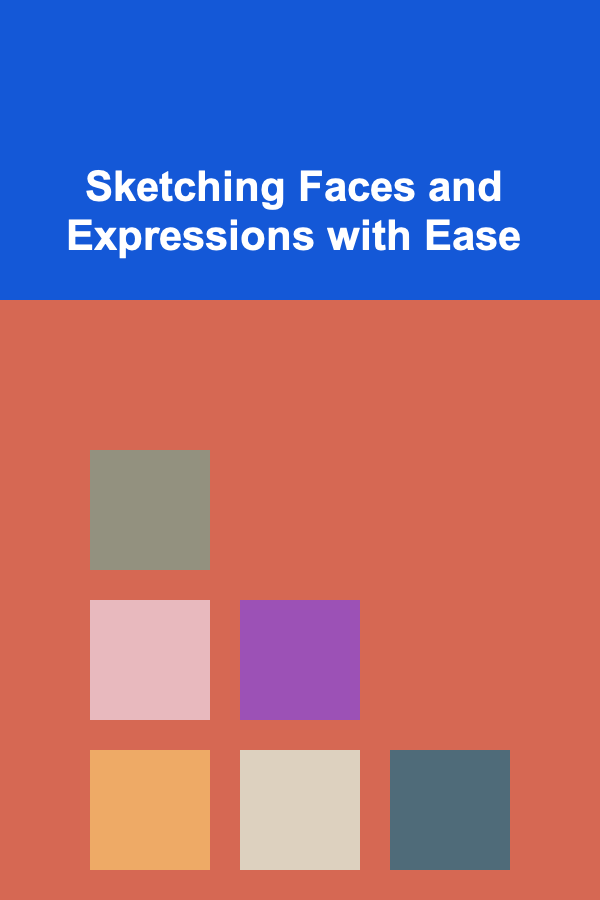
Sketching Faces and Expressions with Ease
ebook include PDF & Audio bundle (Micro Guide)
$12.99$11.99
Limited Time Offer! Order within the next:

The human face is a fascinating and complex subject for artists. Capturing its nuances and, more importantly, its expressions, is a rewarding but challenging skill. This guide aims to break down the process of sketching faces and conveying emotions with ease, focusing on foundational principles, step-by-step techniques, and practical tips to improve your artistic abilities. We'll explore everything from basic anatomy to subtle cues that communicate a wide range of emotions.
Understanding Facial Anatomy: The Foundation of Believability
Before diving into sketching, a basic understanding of facial anatomy is crucial. You don't need to become a medical expert, but knowing the underlying structure will significantly improve the accuracy and believability of your drawings. Think of it like building a house -- you need a solid foundation before adding the walls and roof.
The Skull and Underlying Structure
The skull dictates the fundamental shape of the head. Key features to be aware of include:
- The Cranium: The rounded upper part of the skull, providing the overall shape of the head.
- The Brow Ridge: The bony projection above the eyes, influencing the depth and shape of the eye sockets.
- The Cheekbones (Zygomatic Bones): These bones are prominent and greatly influence the width of the face, especially the mid-face.
- The Mandible (Jawbone): Defines the lower part of the face and its shape varies considerably.
Understanding how these bony structures influence the surface features is key to creating realistic portraits. Feel the contours of your own face to get a better sense of where these bones are located.
Muscles and Their Role in Expression
Facial expressions are created by the complex interplay of dozens of muscles. Some key muscle groups to focus on include:
- The Orbicularis Oculi: The muscle around the eyes responsible for squinting, winking, and crow's feet. Its action is crucial for conveying happiness and laughter.
- The Zygomaticus Major and Minor: These muscles pull the corners of the mouth upwards, creating a smile. Their degree of contraction determines the intensity of the smile.
- The Frontalis: The muscle on the forehead that raises the eyebrows, creating expressions of surprise, concern, or curiosity.
- The Corrugator Supercilii: Located between the eyebrows, this muscle draws the eyebrows downwards and inwards, creating a frown or a look of concentration.
- The Orbicularis Oris: The muscle around the mouth, involved in puckering, kissing, and speaking.
- The Mentalis: Located on the chin, this muscle raises and wrinkles the chin, often associated with doubt or disdain.
Studying these muscles and their effects on the face is essential for drawing believable expressions. Observe yourself and others in a mirror, paying close attention to how different emotions affect facial muscle movement. Online resources and anatomy books can provide detailed illustrations of these muscles.
The Loomis Method and Simplifying the Head
The Loomis method, popularized by illustrator Andrew Loomis, is a powerful tool for simplifying the construction of the head. It provides a framework for accurately placing facial features and understanding the head's three-dimensional form. While there are other methods, the Loomis method is a great starting point for many artists.
Drawing the Sphere and Plane
- Start with a Sphere: Draw a perfect circle. This represents the cranium.
- Divide the Sphere: Draw a line down the center of the sphere (the vertical axis) and a line horizontally (the brow line).
- Create the Face Plane: Extend the vertical axis downwards and create a slightly curved plane intersecting the bottom half of the sphere. This plane represents the face. The length of this plane determines the overall length of the face.
Placing Facial Features
- The Brow Line: This is the starting point for placing the eyes.
- The Nose: The bottom of the nose is typically halfway between the brow line and the chin.
- The Mouth: The mouth is usually located about one-third of the way down from the nose to the chin.
- The Eyes: The eyes are typically one eye-width apart. Each eye is roughly one eye-width wide.
- The Ears: The top of the ear usually aligns with the brow line, and the bottom aligns with the base of the nose.
This is a simplified approach, and individual proportions vary. Use this as a starting point and adjust based on your subject.
Practicing with Different Angles
The Loomis method is particularly useful for drawing heads at different angles. Simply rotate the sphere and adjust the face plane accordingly. Pay attention to how the relative positions of the facial features change as the head turns.
Breaking Down Facial Features: Step-by-Step
Once you have a basic head structure, it's time to focus on individual facial features. Here's a breakdown of how to approach sketching each feature:
The Eyes: Windows to the Soul
- Start with the Basic Shape: The eye is not a perfect almond shape. It's more like two arcs joined by slightly curved lines. The upper eyelid typically covers the upper part of the iris.
- The Iris and Pupil: The iris is the colored part of the eye. The pupil is the black center. Remember to leave a small highlight on the iris to give the eye a sense of life.
- The Eyelids: The eyelids have thickness. Don't just draw a thin line. Indicate the thickness, especially on the upper eyelid.
- Eyelashes: Eyelashes grow out of the eyelids, not directly from the eye itself. They curve outwards and are typically thicker on the upper eyelid.
- The Brow: The eyebrow follows the shape of the brow ridge. The shape and position of the eyebrow are crucial for conveying emotion.
Practice drawing eyes from different angles and with different expressions. Pay attention to how the eyelids and eyebrows change with different emotions.
The Nose: Defining Character
- Simplify the Structure: The nose can be broken down into simple shapes: a wedge for the bridge, a sphere for the bulb, and two cylinders for the nostrils.
- The Bridge: The bridge of the nose connects to the brow ridge. Its shape can be straight, curved, or angular.
- The Bulb: The bulb of the nose is the rounded tip. Its shape and size vary greatly.
- The Nostrils: The nostrils are usually hidden from a frontal view. Indicate their presence with subtle shading.
- Shading: Use shading to define the shape of the nose and create depth. Pay attention to how light falls on the different planes.
Avoid outlining the entire nose. Instead, use shading and subtle lines to suggest its form.
The Mouth: Expressing Emotion
- The Lip Line: The lip line is the most defining feature of the mouth. It's not a straight line but rather a series of curves and angles.
- The Upper Lip: The upper lip is usually thinner than the lower lip. It has a cupid's bow in the center.
- The Lower Lip: The lower lip is typically fuller and rounder than the upper lip.
- The Corners of the Mouth: The corners of the mouth are important for conveying emotion. They can be turned up for a smile or down for a frown.
- Teeth: Only show teeth when the mouth is open wide. Avoid drawing every single tooth. Instead, suggest the overall shape of the teeth.
The mouth is incredibly expressive. Practice drawing different expressions, paying attention to how the lip line and corners of the mouth change.
The Ears: Often Overlooked
- Simple Shape: The ear can be simplified into a "C" shape with internal details.
- Placement: Remember the top of the ear aligns with the brow line, and the bottom aligns with the base of the nose.
- Internal Details: Include the helix (the outer rim), the antihelix (the inner rim), and the earlobe.
- Shading: Use shading to define the form of the ear and create depth.
While often overlooked, accurate ear placement and detail contribute to the overall believability of a portrait.
Conveying Expressions: The Language of the Face
Capturing accurate facial features is only half the battle. The real challenge lies in conveying emotions. Understanding how different muscles contribute to specific expressions is crucial.
Happiness/Joy
- Raised Cheekbones: The orbicularis oculi muscle contracts, raising the cheeks and creating wrinkles around the eyes (crow's feet).
- Turned-Up Corners of the Mouth: The zygomaticus major and minor muscles pull the corners of the mouth upwards, creating a smile.
- Slightly Closed Eyes: The eyes may be slightly narrowed or squinted due to the contraction of the orbicularis oculi.
Sadness/Grief
- Turned-Down Corners of the Mouth: The corners of the mouth droop downwards.
- Inner Eyebrows Raised: The inner corners of the eyebrows may be slightly raised, creating a furrowed brow.
- Drooping Eyelids: The eyelids may appear heavy and drooping.
Anger/Frustration
- Lowered Eyebrows: The eyebrows are drawn downwards and inwards.
- Tensed Jaw: The jaw may be clenched.
- Narrowed Eyes: The eyes are often narrowed, and the gaze may be intense.
- Lip Tension: The lips may be pressed tightly together or curled into a snarl.
Surprise/Shock
- Raised Eyebrows: The frontalis muscle raises the eyebrows high on the forehead.
- Widened Eyes: The eyes are wide open, revealing more of the iris and white of the eye.
- Open Mouth: The mouth is often open, sometimes forming an "O" shape.
Fear/Anxiety
- Widened Eyes: Similar to surprise, the eyes are widened, but the eyebrows may be drawn closer together.
- Tensed Mouth: The mouth may be tense and slightly open.
- Raised Eyebrows: The eyebrows may be raised, but not as dramatically as in surprise.
These are just basic examples. Emotions are often complex and nuanced, involving a combination of different muscle movements. Observe people carefully and study references to understand the subtle variations in facial expressions.
Tips and Techniques for Improvement
Consistent practice is the key to improving your sketching skills. Here are some additional tips and techniques to help you along the way:
Practice Regularly
Even short, regular practice sessions are more effective than infrequent, long sessions. Aim for at least 15-30 minutes of sketching each day.
Use References
Don't be afraid to use references. Photographs, portraits by other artists, and even your own reflection can be valuable resources. Pay attention to details like lighting, proportions, and facial expressions.
Start with Simple Shapes
Begin by breaking down the face into simple geometric shapes. This will help you understand the underlying structure and proportions.
Focus on Proportions
Pay attention to the relative proportions of the facial features. Use the Loomis method or other techniques to ensure that the features are placed accurately.
Experiment with Different Mediums
Try sketching with different mediums, such as pencils, charcoal, pens, and digital tools. Each medium has its own unique properties and can help you develop different skills.
Study Anatomy
Continue to study facial anatomy. The more you understand the underlying structure, the more realistic your drawings will be.
Observe People
Pay attention to the faces of the people around you. Observe their expressions, their unique features, and how light falls on their faces. This will help you develop a better understanding of the human face.
Practice Gesture Drawing
Gesture drawing is a quick and loose way to capture the essence of a pose or expression. Practice gesture drawing to improve your ability to capture movement and emotion.
Don't Be Afraid to Make Mistakes
Everyone makes mistakes when learning to draw. Don't be discouraged by your mistakes. Instead, learn from them and keep practicing.
Seek Feedback
Share your work with other artists and ask for feedback. Constructive criticism can help you identify areas for improvement.
Use Value to Define Form
Value, or the lightness or darkness of a tone, is crucial for creating the illusion of three-dimensionality. Use shading to define the planes of the face and create depth.
Pay Attention to Lighting
Lighting plays a significant role in how we perceive faces. Pay attention to how light falls on the face and how it creates shadows and highlights. This will help you create more realistic and dynamic drawings.
Vary Your Line Weight
Varying the thickness of your lines can add depth and interest to your drawings. Use thicker lines to define the edges of forms and thinner lines to suggest details and texture.
Use Negative Space
Pay attention to the space around the face. This negative space can help you see the overall shape and proportions more clearly.
Be Patient
Learning to sketch faces and expressions takes time and effort. Be patient with yourself and don't give up. With consistent practice, you will see improvement.
Find Your Style
As you develop your skills, you'll start to develop your own unique style. Experiment with different techniques and approaches to find what works best for you.
Conclusion
Sketching faces and expressions is a journey of continuous learning and exploration. By understanding basic anatomy, practicing fundamental techniques, and observing the world around you, you can develop the skills to capture the beauty and complexity of the human face. Remember to be patient, persistent, and to enjoy the process. The ability to convey emotions through your art is a powerful skill that will bring you joy and fulfillment.

How to Build a Security Plan for Your Home Office
Read More
How to Generate Passive Income and Achieve Financial Freedom
Read More
How to Make Money Online as a Mechanical Engineer: 10 Actionable Ideas
Read More
How to Respond to Tenant Complaints in a Professional Manner
Read More
Mastering Efficiency: Strategies for Successful Factory Supervision
Read More
10 Tips for Cross-Stitching Miniature Landscapes
Read MoreOther Products

How to Build a Security Plan for Your Home Office
Read More
How to Generate Passive Income and Achieve Financial Freedom
Read More
How to Make Money Online as a Mechanical Engineer: 10 Actionable Ideas
Read More
How to Respond to Tenant Complaints in a Professional Manner
Read More
Mastering Efficiency: Strategies for Successful Factory Supervision
Read More